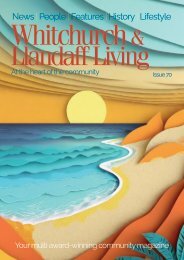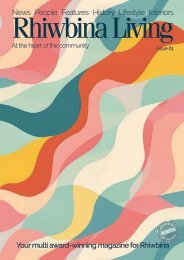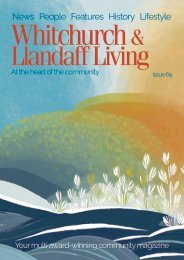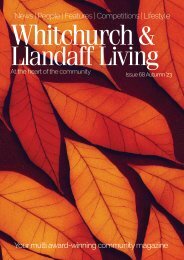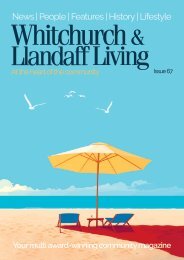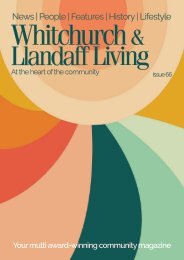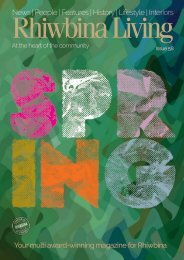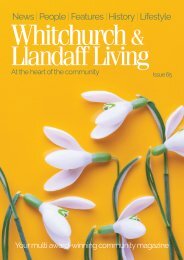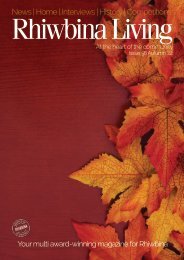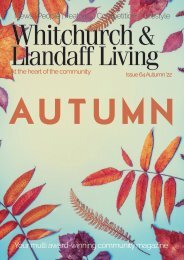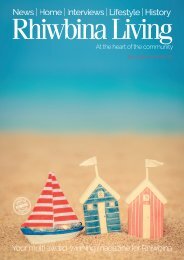Rhiwbina Living
Summer 2023 issue of Rhiwbina Living, the award-winning magazine for Rhiwbina.
Summer 2023 issue of Rhiwbina Living, the award-winning magazine for Rhiwbina.
- TAGS
- wales
- whitchurch
- rhiwbina
- cardiff
You also want an ePaper? Increase the reach of your titles
YUMPU automatically turns print PDFs into web optimized ePapers that Google loves.
the tithe<br />
Is the <strong>Rhiwbina</strong> we know now very different to the one that existed<br />
200 years ago? Nigel Lewis goes back in time to find out<br />
By Nigel Lewis<br />
Midsummer Day was on the 24th<br />
June this year, and it started me<br />
thinking about midsummers in<br />
<strong>Rhiwbina</strong> in earlier times.<br />
In 1801, the population of the<br />
whole parish was less than 700<br />
and the population of <strong>Rhiwbina</strong> (or<br />
Rhyd-y-Walla as it was called then)<br />
would have been no more than<br />
70-100 folk. They would have been<br />
living in one of the five or six local<br />
farms or the scattered cottages<br />
nearby; hardly big enough to call<br />
itself a hamlet!<br />
There was a mill, probably a forge,<br />
and perhaps a beerhouse. No<br />
churches or chapels back then.<br />
So, what would <strong>Rhiwbina</strong> have<br />
looked like? There would have been<br />
footpaths, rough stone tracks for<br />
farm wagons and lots of open fields<br />
with hedgerows. There would have<br />
been many trees too, with areas of<br />
ancient woodland, and of course<br />
20<br />
the stream Nant-Waedlyd running<br />
through.<br />
There was a road (of sorts) further<br />
east running up to Thornhill, and<br />
linking with Cardiff to the south.<br />
Then there was the ancient route<br />
through Whitchurch to Llandaff<br />
via a ford across the River Taff. The<br />
whole of the area was self-sufficient<br />
and there was hardly any reason<br />
to travel. <strong>Rhiwbina</strong> back then had<br />
hardly changed since medieval<br />
times.<br />
Midsummer in such a rural area<br />
was as close to a hive of activity<br />
as could be imagined. Dawn, well<br />
before 6 o’clock, and not getting<br />
dark until 10, this was a busy time<br />
for the whole hamlet. Everyone<br />
turned out, from the youngest<br />
to the eldest. Everyone had their<br />
particular role.<br />
Nowadays, if we have time and<br />
a garden, we might grow some<br />
flowers and a few tomatoes. Two<br />
hundred years ago, every cottage<br />
would have to grow sufficient<br />
vegetables to sustain the family<br />
for the whole year. Back then, not<br />
only was everyone incredibly busy<br />
in the fields, but there was also the<br />
cottage garden to tend to.<br />
The local farms varied in size from<br />
just a few fields to twelve or more<br />
for the larger ones. All the work<br />
was labour-intensive and even the<br />
smallest farm could probably share<br />
plough horses and have at least<br />
one cow for milking. The larger<br />
farms might stretch to a few horses.<br />
Even in the cottages, there would<br />
be ducks, and hens for eggs, bees<br />
for honey, and pigs! The parish was<br />
famous for its pigs. There would be<br />
lots of farm dogs and cats (the cats<br />
for mousing and ratting!).<br />
In midsummer, the hedgerows<br />
would be full of wildflowers, but<br />
the ‘countryside smells’ would have<br />
been pungent!<br />
So, who were the farmers, their<br />
wives and farm workers? There<br />
were no proper records before the<br />
middle of the century (apart from<br />
Sketch: Nigel Lewis





